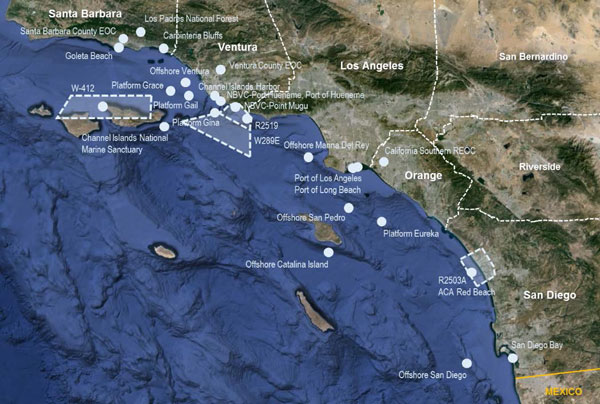In the spring of 2018, GT2’s Center for Threat Management will conduct the twelfth-annual Coastal Trident Regional Port and Maritime Security Program.
Coastal Trident 2018 will consist of scenario-based training, field experiment, and exercise activities conducted throughout Southern California and present participants with unique opportunities to examine specialized port and maritime capabilities.
What is Coastal Trident?
Coastal Trident is an operational research program conducted annually to advance the state of the art in addressing threats to maritime commerce, port and maritime operations, and critical maritime infrastructure. The program is conducted in partnership with stakeholders in port and maritime security and emergency response to support evaluation of operational and technological capabilities.
The activities that comprise Coastal Trident offer unique value through establishment of the following opportunities:
- Scenario-based operations to increase proficiency and evaluate specialized tactics, techniques, and procedures, contingency response plans, and experiment with novel concepts of operation
- Relevant and realistic test and experimentation environment incorporating representative end users to validate concepts of employment and accelerate operational feedback on developing and transitional technologies
- A “whole of society” focus that addresses the complex dynamics in coordination of authorities, jurisdictions, capabilities, and capacity associated with port and maritime security and response operations
Coastal Trident is recognized as the largest sustained port and maritime security program in the nation and regularly involves the participation of more than 150 public and private sector organizations.
Coastal Trident 2018
In 2018, Coastal Trident will be conducted to examine the capabilities of Navy and Joint-DOD; federal, state, and local government; and private sector organizations to address the operational and technical challenges presented by asymmetric threats in the port and maritime domain.
Coastal Trident incorporates a modular construct, which serves to control interactions between program elements as appropriate. This modularity minimizes technical and operational risk while allowing for participants with differing priorities, levels of proficiency, and technical maturity to leverage program resources.
Program modules are determined by the priorities of participants (objectives are “crowd-sourced”) and funding is determined by the level of effort required to support planning and conduct of collaborative activities (sponsorship and material resources are “crowd-funded”), minimizing the burden shouldered by any single participant.

Coastal Trident leverages a network of strategic partners to provide specialized operational and material resources throughout Southern California, in order to support the design and implementation of a diverse, realistic, and relevant test environment.
These resources include facilities at the Ports of Hueneme, Los Angeles, Long Beach, and San Diego; government and commercial test and target vessels; land and sea test ranges at Naval Base Ventura County and Marine Corps Base Camp Pendleton; offshore oil and gas facilities; personnel and equipment maintained by federal, state, and local government agencies; and a technology base comprised of subject matter experts from the public and private sector.
Priority Areas of Interest
In addition to the objectives communicated by participant organizations, the CT-18 planning team has prioritized the following areas of interest, in order to address capability gaps identified during previous programs:
Domain awareness and information superiority
- Unattended, distributed, and networked sensors
- Maritime communications and data links
- Data fusion, visualization, and decision support tools
- Passive surveillance, reconnaissance, and threat detection
- Cyber and electromagnetic threat detection and resilience
Remotely-operated, unmanned, and autonomous systems
- Standoff threat detection, identification and hazard monitoring
- Persistent and beyond line-of-sight surveillance and reconnaissance
- Support to close quarters combat and confined space operations
- Unmanned systems threat detection and countermeasures

September 22, 2017
Concept Development Meeting:
October 11, 2017
Initial Planning Meeting:
December 6, 2017
Mid-term Planning Meeting:
February 7, 2018
Final Planning Meeting:
April 11, 2018
Program Execution:
May 21 through June 1, 2018
Who Participates in Coastal Trident?
Coastal Trident is designed to meet the needs of a diverse set of stakeholder and participant organizations, while promoting “whole of society” innovation and collaboration through timely and relevant scenarios.
Federal Government
-Navy and Joint-DOD organizations
-Lead federal agencies
-Specialized response organizations
-Port and maritime security stakeholders
-Science & technology organizations
State Government
-Specialized response organizations
-Port and maritime security stakeholders
-Academic institutions and laboratories
Local Government
-First response organizations
-Port and maritime security stakeholders
-Port authorities and special districts
Private Sector
-Technology developers and subject matter experts
-Port and maritime operations and security stakeholders
-Logistics and surge capacity providers
-Academic institutions and laboratories
If you would like to contact us regarding research opportunities, current and upcoming programs, or general information, we welcome your inquiries.
